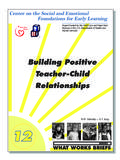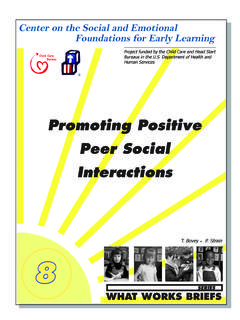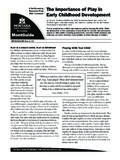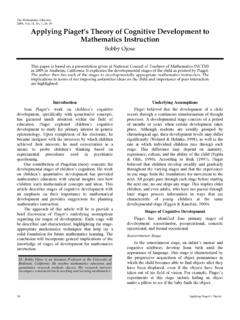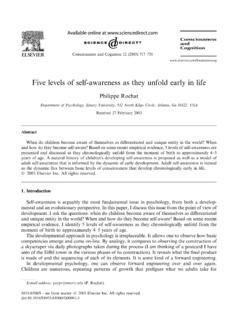Transcription of The Importance of Communication Skills in Young Children
1 RESEARCHBRIEFH uman Development Institute University of KentuckySUMMER 2013 The Importance of Communication Skills in Young ChildrenCaroline Gooden, Co-Principle Investigator, Kentucky Early Childhood Data System (KEDS)Jacqui Kearns, Principal Investigator, Project TAALC, and Associate Director, Inclusive Large Scale Standards and Assessment, Human Development InstituteLet s consider the Importance of Communication for Young Children . As one of the major developmental tasks in early childhood, learning to communicate is key for Children to interact with the persons in their world and to have their needs met. Few tasks in early childhood are as important as this one! Communication development for Young Children includes gaining the Skills to understand and to express thoughts, feelings, and information. Understanding Communication begins before birth (during pregnancy) and continues through life, as a child hears, sees, and interprets information from other people.
2 The expression of Communication or a child s language begins with head, eye, and body movements, as well as through simple vocalizations and hand motions. Language expression progresses to words, sentences, and conversations through many methods including gestures, spoken words, sign language, pictorial language systems, and Communication boards. It is essential that a child have one of these functional means of expressive language before going to kindergarten. Bloom (1988) describes Communication development as guided by the need for relevance ( , communicating what is important), discrepancy ( , seeking to establish consistency of information), and elaboration ( , learning more complex language Skills ). Communication is essentially a symbol-manipulating system that is present in very Young Children and that increases in complexity with age (Pinker, 1999).
3 During the early childhood years, responsive families and teachers are critical for rich stimulation of Children s Communication Skills . Appropriate stimulation helps all areas of Children s development (Bredekamp & Copple, 1997). Conversely, limited stimulation can significantly hinder a child s development (Hart & Risley, 1995). Since this area is so important to Children s development, let s consider what we currently know about KY Children s Communication and some resources that support this important s Early Childhood Assessment MethodKentucky (KY) has a progressive early childhood plan for gathering information on Children s development as outlined in a guidance document called Kentucky s Early Childhood Continuous Assessment Guide (KDE, 2004). This guide explains recommended ways to assess Children s development from birth until kindergarten.
4 Most educational programs in KY follow this process by continuously assessing Children s growth in the child care, First Steps, Head Start, and preschool programs in which they are enrolled. As a further result of this early childhood plan, assessment results are gathered for Children in First Steps and state-funded preschools by a project at the Human Development Institute called the KY Early Childhood Data Systems or KEDS. As a result of KY s progressive system of assessing and gathering data through the KEDS project, there are several An update on HDI s research in the field of developmental disabilitiescontinued insideHDI Research Brief Summer 2013important sources of information about Children s language development. First and most importantly, teachers, child care providers, and families who follow the Assessment Guide process gather detailed information about individual Children s Communication Skills on a daily basis.
5 As one example, when teachers and families complete an assessment for a child named Jerri, they learn that she can express her needs in two-word signed language sentences. Teachers and families monitor Jerri s Communication Skills on a daily basis and discuss her progress whenever they meet. In addition, teachers and families can use their assessment system and its school-specific reports to track her progress and to plan next steps for her development. This assessment process and the Communication it encourages between school and families provide a rich source of information about Jerri s second source of information about Kentucky Children s Communication is the state-wide progress reports that KEDS sends to First Steps and the KY Department of Education (KDE) preschool administrators. Information about Children s progress, including their Communication Skills , is summarized in the next sectionFindings from the Early Childhood Assessment PlanInformation about Young Kentucky Children s Communication development is gathered and reported to First Steps and KDE administrators, teachers, providers, and the public through each program s website ( and ).
6 This information includes the annual results for three broad outcomes for development for KY s Young Children with developmental delays. One of these outcomes relates to Children s Communication , as it describes the development of knowledge and Skills which includes Children s abilities to understand and to use language in many ways (gestures, sign language, spoken word, Communication devices). Two levels of progress are reported for this outcome, including the percentage of Children who 1) make substantial progress (that is, their school and family support significantly improves their language), and 2) leave the program with age-appropriate Skills for that outcome. Several points may help explain the results for this broad outcome. First, some Children are included in both levels of progress, so that the percentages for each year are greater than 100%.
7 Second, the assessment instruments and Children served by First Steps and by preschool programs differ; thus, results are not comparable across programs. First Steps serves Children aged birth to three years with diagnosed developmental delays, and their continued from front pageTable 1: Two-Year Results: Development of Knowledge and Skills for KY Children with Developmental Delays2010-2011 School Year2011-2012 School YearOutcomeLevels of ProgressChildren leaving First Steps Children leaving KDE preschool Children leaving First Steps Children leaving KDE preschool Children s Development Of Knowledge And Skills1) Percent Who Made Substantial Progress95%87%95%72%Levels of ProgressChildren leaving First Steps Children leaving KDE preschool Children leaving First Steps Children leaving KDE preschool 2) Percent Who Exited with Age-Appropriate Skills48%72%*48%28%*During the early childhood years, responsive families and teachers are critical for rich stimulation of Children s Communication skillsassessments include considerable detail to measure the rapidly changing development of infants and toddlers.
8 By contrast, since KDE preschools primarily serve economically disadvantaged 4-year-olds and Children with developmental delays from 3 years of age, their assessments measure broader areas of development from 3 to 4 years. Third, the KDE data over the two-year-period show decreasing percentages of Children making substantial progress and leaving with age-appropriate Skills (see * percentages in Table 1); this change does NOT reflect a change in our preschool population! Rather, most of the preschoolers in KY were assessed with an instrument that changed its scoring criteria in the second year, resulting in lower scores but not lower levels of skill , the data in the table include the first few years of data collection for both programs, and thus all findings are tentative and reflect general trends rather than child-specific information. Table 1 shows the results for two years for this outcome, for Children as they leave First Steps and as they leave preschool.
9 The majority of Children (more than 70% for both programs for both years) made substantial progress in the development of their knowledge and Skills , which is a wonderful endorsement of the work of these programs and their families! At least 30% of the Children exited First Steps or preschool with age-appropriate knowledge and Skills , which is a significant accomplishment since the programs are designed for Children who need enriched early intervention and preschool and ImplicationsWhen Communication needs are not addressed:A seven-state study of students participating in state assessments found that approximately 12 13% of 3rd grade students are identified by their teachers as communicating primarily through cries or facial expressions and have no clear use of gestures, pictures, signs, or words) (Kearns, Towles-Reeves, Kleinert, Kleinert, & Kleine-Kracht Thomas, 2011).
10 While these students represent a very small population with the most significant cognitive disabilities, the findings are nevertheless very important for language development. In order to participate in the curriculum in K-12 based on the Common Core State Standards (CCSS), the ability to communicate with peers and teachers is essential for students to access, engage, and progress in classroom activities and the curriculum. Participating and progressing in the general curriculum language arts, math, science, and social studies are essential for continued language development. Participating in the school curriculum with typical peers also provides the opportunity to develop social Skills alongside peers who are proficient language users. Students who are not using oral speech, as well as students who are emerging in their use of Communication ( , using understandable Communication through gestures, pictures, objects, but not yet at a fully symbolic level) must have systematic and comprehensive Communication intervention beginning in early intervention, throughout preschool, and continuing until the student graduates from high school.




